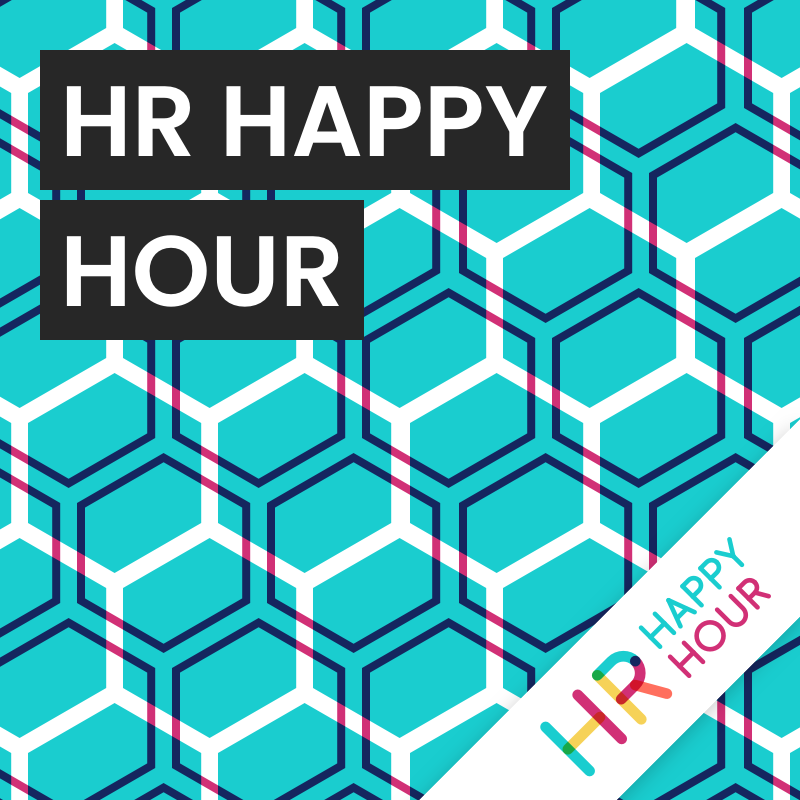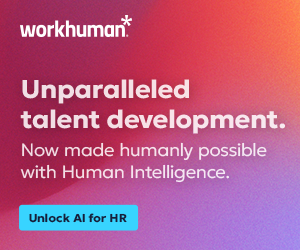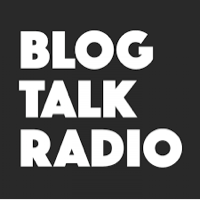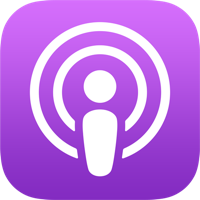HR Happy Hour 496 – Supporting Neurodiversity in the Workplace
Hosted by

Steve Boese
Co-Founder and Chief Data Officer of H3 HR Advisors and Program Chair, HR Technology Conference

Trish Steed
Co- Founder and Chief Strategy Officer, H3 HR Advisors
About this episode
HR Happy Hour Episode 496 – Supporting Neurodiversity in the Workplace
Hosts: Steve Boese, Trish Steed
Guest: Ed Thompson, CEO and Founder of Uptimize
This episode of the HR Happy Hour is brought to you by Paychex, one of the leading providers of HR, payroll, retirement, and insurance solutions for businesses of all sizes.
Paychex just released its 2021 Pulse of HR Report, which sheds light on what businesses need to do right now to meet the new expectations of a workforce no longer satisfied by the status quo. The fifth annual report provides an in-depth look at how HR professionals are contributing to the success of the companies they serve during this transformative time. To learn how your peers are navigating the start of a new workplace era, download the report at payx.me/pulse21.
This week we talked with Ed Thompson from Uptimize about neurodiversity at work, embracing diversity of thought, and how inclusion looks when attracting and training new talent.
– What is neurodiversity?
– How to approach different thinking styles in the workplace
– Targeted trainings for us through the employee lifecycle
– How is productivity affected if an organization isn’t supportive of neurodiversity?
Thank you Ed, for joining us! Remember to subscribe to the HR Happy Hour wherever you get your podcasts.
Transcript follows:
Steve 0:25
Welcome to the HR Happy Hour Show with Steve and Trish, sponsored by our friends at Paychex. Today we are going to be talking about neurodiversity at work, embracing diversity of thought and how inclusion looks when attracting and training new talents. The topic we love. We’ve covered it some on the show and I can’t wait to talk about it some more today. Trish, but first the question for you. Here’s the question. I think this is a good one. What luxury item or service do you feel is totally worth the price?
Trish 0:56
That is so easy. These questions usually stump me I have to say but this one something popped right into mind. I get made fun of for it. So I will tell you, when I am in Las Vegas, especially if you’re at a hotel, you want to go maybe just down the street to dinner, right to a nice restaurant, but it’s gonna take forever in the taxi line. I will get a limo every single time. I don’t care is always worth it. There’s always, you know, four or five people around here like yeah, we’ll go in the limo with you. Right? So it’s that’s my splurge every single time. What about you?
Steve 1:35
Well, I have a very similar answer. And we did not talk beforehand. Nor did you know the question. I wrote down on my little card here, which I’m showing here to the audio listeners. I wrote airport car service. So a clear answer and fairly long my first business trip I think I talked about it on maybe the last podcast, my first business trip since the pandemic and it was like a three city trip I was gone for like 10 days. And then I even decided, you know what, parking my car at the airport and paying for that, which is what I would normally do like most people would do, it was actually less cost to get picked up at my house driven to the airport. And then likewise on the way back not an Uber not a taxi. I’m talking about like proper car service. It was totally worth it. So good.
Steve 1:35
We are very excited to welcome our guests Ed Thompson. He’s the CEO and founder of Uptimize, a unique corporate training platform that helps organizations attract, hire and retain talent that thinks differently. Uptimize works globally with organizations like Salesforce, JP Morgan, Chase, Deloitte and IBM building robust and impactful neurodiversity at work programs, and has also been a frequent speaker on the topic of neurodiversity in the workplace and is currently writing a book on the subject. Ed has relocated to Denver, Colorado from the UK with his wife, Emily and his new dog Cleo. Welcome, how are you doing?
Ed Thompson 3:02
Yeah, great to be here.
Steve 3:03
Awesome. Want to weigh in on the on the luxury item question or you want to think about it?
Ed Thompson 3:07
Yeah. You guys got me thinking about cars. I tell you what, one that didn’t work that well. My wife and I were in the UK the other day and I paid to get an Uber for about a 40 minute drive. And I got the comfort Uber where you can say do you want conversation? My wife, she’s not a morning person so she said definitely no conversation. I just want to say, she’s like, this is brilliant, nice comfy car, nice drive to the airport. Apparently within a minute, you know, the guy’s like, Hey, how you doing? You know, you want to chat. So she said it just the whole thing just didn’t work at all. But I think for me, I might go elegant clothes, blazers, that kind of thing. I must say that I”m a feast or famine dresser. It’s either kind of you know, a Nike tracksuit or kind of an Italian suit. I want to look good. I want to feel good.
Steve 4:08
Nice. I love it. All right. Well, thank you, Ed, for joining us today. Again, we’re going to talk about neurodiversity at work and some of the things you guys do to help organizations embrace this and support people who think differently. I love that in the bio, the maybe just to level set us and set the context for the conversation. And if you don’t mind, can you share just your perspective of what do we mean by neurodiversity and then we’ll kind of fold in some of the conversation around workplace and hiring and training etc.
Ed Thompson 4:39
So I think it’s really important to start here. Neurodiversity itself is nothing new. It’s new that we’re talking about it so much, but in itself, it’s nothing new. It’s one of the most fundamental things about humanity in a sense, the natural diversity of human brain wiring, in a sense, everybody processes input differently, there’s no one standard brain. But we know that within that human universe, some thinking styles and traits can be more common. And the fact of those being more common can lead to norms that disadvantage people who are in multiple overlapping neuro minority groups such as autistic people, dyslexic people, ADHD. So examples of that kind of norm in the workplace disadvantages certain groups could be things like an over reliance on interviewing as a way of assessing candidates, you know, that can disadvantage people who find that particular type of interaction. And in a sense, that type of information processing particularly challenging and stressful or noisy, open plan offices that can distract people with acute sensory sensitivity. I think what’s happened and you’re why we’re talking about this so much now is that we recognize over the last 1020 years that neurodistinct people, so people within those groups I mentioned, represent a huge demographic, right, and that’s our understanding of that, you know, continues to develop, then also noticing people breathing very, very significant strings. And while those air quote conditions have always been diagnosed, based on challenges, actually, you look at the top of almost any field of life, whether it’s, you know, sports, the Olympics of business, you find neurodistinct, significant neurodistinct representation at the top of those fields. And we also recognize thanks to disability advocacy, really, that many of the challenges faced by neurodistinct people at work or in society, are actually the result of an inclusive environments and inclusive processes or in fact, an inclusive people who aren’t educated and prepared to welcome those differences. But I think when we talk about neurodiversity, the biggest recognition should be that this has always been a fact about our humanity. It’s always been a fact about workplaces and of any human collaboration, we’ve just done a poor job of recognizing it, you know, celebrate it.
Trish 7:20
Thank you for giving that description. Because as you’re sitting there and kind of talking about that, and I’m thinking back over most of my career was spent in human resources, I’ve recruited and interviewed literally 1000s of people over my career. And it’s very rare when I think back of, of times where someone might have either self identified as having some sort of any, you know, I don’t want to say a challenge, just but a difference. I loved how you talked about it being neuro distinct. Can you maybe talk a little bit about that? Because I feel like I don’t think I would be in the minority, not always knowing when someone might have, you know, dyslexia or be on the spectrum. So can you talk about maybe like what you’re seeing in organizations? How can people know or even attempt to know is that something that people are curious about right now?
Ed Thompson 8:12
I would argue that the goal of attempting to know, in a sense is is a long goal. And I think it’s also almost an unachievable goal, a percentage of our clients come to us, and and that’s their framework. So they say, how do we know who’s dyslexic? How do we know who’s ADHD? How do we get them to put their hand up, and then we know kind of what to do for them. And I think that’s challenging, and a lot of different levels. In a practical sense. I mean, a lot of people who are new or distinct have have not had good experiences, you know, in education or at work, and therefore, don’t necessarily want to tell organizations that they need to see more from the organization first, in order to be willing to disclose, and then lots of people who may be neurodistinct in the sense that they could receive a diagnosis, haven’t had access to that and don’t have that self awareness. So you say, okay, let’s get everybody who’s an ADHD or to kind of put their hand up, I think is is challenging and difficult. And again, you know, you think about a recruiter, and Trish, you mentioned hiring people, not everybody is going to tell you straight away, you know, some of our focus groups would say, look, I want to disclose but I’m not going to disclose until I have a manager I trust and so on. So, we’re operating by definition in a world where we don’t necessarily know what somebody’s thinking style is an A nor should we be trying to judge probably, we then have the issue of In fact, people are so varied, that there is no one solution for all, no one type of support for any particular group, we have one client who, on one occasion, decided they wanted to do more for their dyslexic stuff. So they got three dyslexic employees in a room and said, Look, we want to do more for people that you would do we do. They get ready for analysis. So I think both the identification and then the support is, by definition, you know, challenging and varied. So you might well be asking at this point, okay, so what do we do?
Steve 10:28
And yeah, that’s the follow up, right. So that’s challenging and difficult to do, and maybe counterproductive, as you said, when an organization maybe either comes to optimize or just just in general, right? If I’m in an organization where, hey, I think this is important for us for reasons we can talk about, like, where do you even begin, I guess maybe it’s the question.
Ed Thompson 10:48
It is where we begin. And there’s also how we, how we approach this. And so I would say, let me start with how we approach it. And then I’ll talk about how that works into sort of where we begin, how we can approach in a in a world where we know everybody has a different brain a different thinking style, a different way of a different preference in how they communicate in how they problem solve. Straight challenges, we would suggest starting with what we call universal design approaches. So what can we do as a manager? What can we do as a recruiter? What can we do as a work environment designer that optimizes things for everybody? Right? That would be the starting point. And then the next level down is really well, knowing that that’s never going to accommodate everybody, there’s always going to be things where somebody is actually, you know, personally, I have this particular preference or need, you know, how do we respond to that in a very person centered and individual way, and we allow people to articulate their own needs, and advocate for their own requirements. And we don’t say, oh, okay, you’re autistic, therefore, this is what you get, or Oh, you don’t have a medical note. All right? Well, we can’t help you. That’s not how to optimize our team. Now, we also know from people in these neuro minorities, that the biggest challenge they have at work is a lack of cultural acceptance. And those two things marry up to create that scenario. So we have to change that. And so we would train organizations, and train the individuals in organizations to be more aware of this universality of neurodiversity to have more empathy and a better understanding of what it means to be say, autistic could work and some of the common challenges and experiences of that demographic. Same for dyslexic people, same for ADHD is and so on. But what we’re not getting from that is, okay, great autistic people are there. So they need that that’s too simplistic, we’re getting really a picture of, of more variety. And so that’s what you have to go back to that approach. What can we do for everybody?
Trish 11:47
You know,I was thinking do you think that we were just dropping the ball when people get to the work phase of their life? I mean, does it seem like, you know, whether it’s K through 12, or even maybe a university that’s being more supportive of people who are neurodistinct, and then we’re dropping the ball at work? Or is it something that’s a challenge even before someone might join our organization? Is it something we just as a society need to work on more?
Ed Thompson 13:39
I think support is very, you know, patchy, regional, there’s certainly people we’ve spoken to who’ve got the workplace and had, you know, really poor experiences in education beforehand. And that may not be the fault of the institution that may simply be because of societal ignorance. You know autistic people are significantly more likely to face bullying in education, and at work, and universities, I think, are a huge mix. There are some universities with very, very strong neurodiversity support programs, but I would say those are probably still the niche or not the norm. So I think that that could be quite varied, but when it when it comes to workplace, I think the important thing is, and we’ve started to see this, you know, before the pandemic, I think catalyzed by the pandemic, it’s about respecting well being is a really important piece of an employee’s experience. And recognizing that well being is not kind of one and done. It’s not, you know, we onboard people, we sort of, you know, ask them are you comfortable, we get a thumbs up and then you know, it see you in six months, you know, wellbeing is an ongoing thing, and we all saw that as organizations with this panic. Quite, suddenly changes everything that you know, people are displaced from their workplace, they happen to family challenges and so on. And so when we talk about your inclusion, we will never have the same control over education and family stuff as we have the workplace, what we can do is recognize that we have a role and responsibility to make sure everybody is comfortable on ongoing basis. And if we apply ourselves to that, we can help include people at a cultural level, but also at an environmental level as well.
Trish 15:35
That makes sense.
Steve 15:36
And we talked a little bit about sort of the approach, right, sort of getting people to understand these issues getting people understand it’s always been in existence, right? Everybody thinks a little differently. And it’s always been the case. And it’s really trying to create a mindset and an awareness, etc. Do you then work with clients? Or is the next step or maybe an ongoing step to be some may be targeted? types of training intervention? We mentioned interviewing earlier. I’m thinking things like maybe collaboration work styles, like we’re all having this call on video cameras today, right? But maybe not everyone wants to be staring at a video camera all day long, talking to people, etc, etc. So do you move on then with as you work with these organizations to some more targeted kinds of trainings or interventions?
Ed Thompson 16:25
Yeah, we have a foundational educational offering, which we call neurodiversity 101, which is designed for everybody. And that’s very carefully put that together in thinking. What does everybody in an organization need to know about this topic? and know what we never want to train people on stuff they don’t need? Right? But that is just the basics of what it is, again, we know most people don’t understand that. So how do we talk about this? Sometimes we see organizations with the willingness to and the will to, to create this conversation, but without the tools, some basics, or you know, what are the true experiences of some of these neuro minorities? How can they overlap? What about intersectionality? You know, how does it play out if somebody is African American and gay and neurodistinct, and what challenges somebody like that faces in terms of exceptions, but then we get on to some more practical stuff, again, relevant for anybody. So collaboration, communication, you know, meetings, things like that, being able to support different types of colleagues how to respond to disclosure, you know, some people have never even know the terms, there’s nothing they feel they need to disclose, but for people who do and again, you know, the LGBTQ plus, community is a good example that, you know, for people who are wrestling with a disclosure, that can be an incredibly, you know, stressful and difficult process.
Ed Thompson 17:49
So, you know, how do we respond to that? How do we support that? And then also, just the basics of hiring, because people get roped into that, you know, so the manager will say, hey, team, can you just interview Chris, and just tell me if you think Chris would be a good fit? Now, what happens if just one of those people knows nothing about neuro diversity? and says, Yeah, you know, what? Chris kind of wasn’t really making eye contact, he didn’t seem that interested, his tone was monotone. You know, I know he has the best resume. But actually, I want to go with John. That’s how we that’s how we don’t hire the best person. And that happens all the time. And it’s, to me, the most striking thing I’ve seen as a leader of this company, is the fact that as organizations, we are regularly not hiring the best people because of a lack of inclusion. And it’s really staggering. I think we just assume that we are, but we’re not we always assume that we are because in organizations we got in right. There’s obviously more to it than that. And so we have specific trainings for recruiters specific trainings, for HR, specific training for managers, who of course, have a key role. And those all build on the foundation and the basics. And what we like to see, and I’m happy to say we do see is we see great enthusiasm from people in those roles. Once they get a taste of this to say, I need more. And we have about 95% of managers, recruiters and HR people who take our foundational training say, I want more, please, because I get it. This is so important. It’s so relevant to what we’re doing. Yeah. Can I have more to think about how I manage my team?
Trish 19:31
Yeah. So it really sounds like the interest is there, which is great. Can you maybe talk a little bit about what are some of the business success stories or business results that you’re seeing organizations that embrace this approach? And being open to this approach? Are they seeing significant business success come out of this?
Ed Thompson 19:53
Yeah. Every organization we’ve ever worked with has had a positive impact on at least one and sometimes more than one of these five things. So, number one, hiring more people who think differently. We know that’s important, not just because organizations are struggling to find talent, but also because people who think differently bring diversity of thought they bring strengths and skills. And and that can be a powerful thing. And to be honest, we still don’t know, on a quantifiable basis, what is the true power of greater diversity of thought, I think we can all rationalize that this is a powerful thing that we should be building it out in our team. So new highs, well being pretty universal, has been that people have self disclosed in organizations where they have brought in neurodiversity initiatives, neurodiversity education. So you know, back to our point Trish about sort of, how do we know who’s who, like, you’re not going to have people self disclose when they’ve seen no evidence that the organization cares about them. But once there’s tangible evidence, the organization’s saying, look, we care about neuro diversity, we’re going to launch a training program, we’re going to maybe do the kind of thing we do, which will be a kickoff event to all staff saying, you know, you’ve never heard us talk about neuro diversity before, actually, it’s really important, we want to make sure that, you know, we include this across the board, surprise, surprise, people start feeling willing to disclose in a way that they never had before. And that can be a powerful thing, you think about the challenge of masking, a lot of people describe not disclosing being incredibly stressful, because you’re trying to pass this neurotypical and that’s, you know, bleeding 30% of your daily energy. This is how I work and then, you know, you start sparking these conversations that lead to productivity. And what we found is, again, everybody has a way of communicating where problem solving a way of organizing their work, you know, now, if I’m an employee, and my manager knows about that, that’s helpful to me. And what we find sometimes with people who are distinct is it’s not just helpful, it’s critical. If you know about that, and you respect it, I can be incredible.
Ed Thompson 22:09
But if you don’t, you don’t respect it. I’m stuck. So productivity is another productivity number three, so new highs, well being productivity. And some organizations have actually seen significantly greater productivity in teams that have become more neuro diverse. I think we have to be careful with that not to imply that there’s some sort of, you know, superpower of people who think differently, but I think that’s powerful, as well innovative thinking as well. We’ve seen organization, several stories of, of teams facing challenges in the pandemic, one organization, for example, where they had their systems are really kind of overwhelmed with clients, questions about insurance, just because the pandemic, suddenly everything changes, everybody’s swamping them. And they very deliberately put together a team of people who thought differently. And they said to that team, come up with a solution as a special project team. And that team came up with a tech solution to help manage that change. This is one example. But it’s one example of the power of teams where we can bring these different perspectives. And then the last one would be retention. Now, not everybody reports on retention. But retention is a huge challenge for corporate America. Right now. I mean, as far as I understand, it’s gone from you know, one in four very soon, one in three. Yeah. I mean, it’s crazy. And that has such a huge cost. And you look at why do people leave, and you look at the data on why people leave, and they leave because they don’t feel understood by their manager. They don’t feel they have good wellbeing, they don’t feel understood by their colleagues, right. And you know, you can start joining the dots there, and thinking, well, not everybody who leaves is new or distinct. But if we change those things, we’re going to be changing that for everybody. And that’s one of the great themes of really enduring inclusion. Back to my point about everybody thinks differently. Any universal approach to acknowledge that and accommodate it has really wide benefits.
Steve 24:20
And I’m going to pause for a second we were talking with Ed Thompson about neurodiversity in the workplace. Trish, we must thank our friends at Paychex. They have released their 20-21 Pulse of HR Report, which sheds light on what businesses need to do right now to meet the new expectations of a workforce no longer satisfied by the status quo. Good pile on to the retention comment right there. The Fifth Annual Report provides an in depth look at how HR professionals are contributing to the success of the companies they served during this transformative time to learn how your peers are navigating the state to start of a new workplace era. Download the report at PAY x.me slash pulse 21, I will put that link in the show notes as well.
Steve 25:02
Yeah, Ed, retention is a critical one. I’m a labor market geek. I’m a geek on a number of things, I suppose we should actually make that the question of the day on the next episode Trish, like, what is the thing you’re a geek about, but I’m a labor market data geek and the quits rate just and mass, right, just a matter of macro level in the United States is absolutely through the roof. It was an all time record two reports ago, and it was close again, on the last report like something like seven and a half million people have voluntarily quit their job in the last like three months or two or three months, the United States. So it’s a huge challenge. And it’s just organizations you work with? Whether it’s the attraction, and the hiring part, certainly obviously important, the retention part, how are they kind of really, you know, seeing kind of the benefits of embrace, I don’t know, just casting a wider net, or being more open minded, etc. Like, you know, what’s the sort of tangible results that that organization see from really thinking about these topics in a more holistic manner?
Ed Thompson 26:11
Well, I think you can go tangible at a quantitative level. And you can say, organizations like SAP seeing a significant jump in retention against norms that’s quantifiable. You can see organizations like JP Morgan seeing, you know, 50, to 90%, and greater productivity, more hires, more people self disclosing, again, these are all positive indicators of change, but, but I would actually call it to the individual case. And I think one of the powerful things you can see is, you know, in most of the organizations we work with, people are well paid. They’re smart, well educated, valuable, people doing valuable work. And nothing gives us more satisfaction than to see a really positive change at an individual level. And now whether that’s an individual saying, thankfully, now, you know, it’s not just on me, and we can have this conversation and people are going to understand the way that I work, or whether it’s a manager saying this is just changing the way that I think about my team, no longer do I give everybody instructions the way I like to receive, because I recognize that it’s a waste of productivity. I ask everybody.
Steve 27:23
Yeah, absolutely. Yeah, I think that makes the most sense to it. Like, that’s the most impactful thing to write like this is HR, we’re talking about in training. So there’s always that age old question of, oh, what’s the ROI of this? Right? So you probably have that conversation with prospects maybe all the time, right?
Ed Thompson 27:40
With different priorities, you know, some people will say, the focus for us is, you know, well being, whatever it is, and we can we can, we can help them with quantitative data on that. But no one’s ever more persuaded, particularly by something new, than by that feedback by those stories. And again, not just the stories, the narratives think, individuals, but also from the recruiters. You know, for example, the manager is saying, this is just opening up so much more in terms of how I work.
Trish 28:16
That’s great examples. I think that’s true with anything right at work. If you, if you’re seeing results that are personally impactful to you, then you’re going to want more of that, right? You want more of that training, you want more of those experiences or that type of culture.
Ed Thompson 28:30
Right, I’ll give you just one more example. I know, examples I helped was a one of the organizations we worked with an investment bank, and they’ve done a really good effort at just giving everybody a baseline familiarity with this topic. So people are confident raising the topic, they’re confident talking about it, they’re confident saying this is something that we care about. And so they’ve hired somebody who was struggling at a competitor was struggling to climb the ladder, a really brilliant guy, not so good with bringing in business and couldn’t see a future for himself. And he never disclosed at the previous employer, but he decided, right, next place I interview, I’m gonna disclose off the back. So I just want to see how they respond. And with our clients, they responded effectively, and they were able to ask him questions, you know, how could you How could we make you be successful? You know, what would you need from your colleagues? What would you need from your manager? And he’s now comfortable and successful in that organization. Again, one example. But in a world where people are leaving, we have this incredible kind of workplace transients. You know, what is that worth? What is it worth getting someone brilliant from a competitor, just because we could have a conversation that they never could have?
Steve 29:50
Yeah, it’s worth it. That’s a great example. I mean, this is slightly off the topic, but I just read a story of a trucking outfit somewhere in the Midwest, I can’t remember what state. Their signing bonuses are as much as $40,000. If you’re a licensed commercial truck driver right now, they’re so hard to find. I’ve got a good truck driving story I’ll tell on some other show but and this was really, really great conversation, the topic of neurodiversity. I decided the tabs important to us. We’ve been having a number of shows over the last year, year and a half on the topic. Our research is coming out soon on sort of inclusion and accessibility in the workplace. There’s there’s elements of neurodiversity that we’re covering in this research, which we’re excited to launch soon, but the company’s Uptimize, that link will be in the show notes. There’s plenty of resources as well for folks to learn more, and then add people can find you on LinkedIn. Is there anything we want to share before we let you go?
Ed Thompson 30:53
Find us on twitter Uptimize team, but yeah, best place to start website Uptimize.com and feel free to drop us a line where we’re running the first, or what we call neurodiversity virtual coffee weeks next week, which is just 20 minutes with one of our subject matter experts just you know, ask us anything you want on the topic. We know lots of people are new to it. And hopefully we can help you, you know, get started on the kind of journey that we can see a Google or an IBM or a Salesforce, you know, beyond and the results that they’ve seen.
Steve 31:24
Yeah, absolutely. And thanks so much. Great stuff. Trish good stuff. I love this topic, you know that and I’m glad we’re able to cover it again.
Trish 31:32
Me too. I think these are the ones where it’s the most impactful and, and really will be evergreen, right? This is a problem that isn’t going away tomorrow. So I think it’s always good to come back and hear more about what organizations are doing and what you can do to help your organization yourself. So awesome. Thank you so much, Ed.
Steve 31:51
Yeah, great. So links will be in the show notes. Remember to subscribe, tell a friend HRHappyHour.net for all the archives and for our guests Ed Thompson, for Trish Steed. My name is Steve Boese, thank you so much for listening to the HR Happy Hour Show. We will see you next time and bye for now.
Transcribed by https://otter.ai
Talk to us
If you want to know more about any aspect of HR Happy Hour Media Network, or if you want to find out more about a show topic, then get in touch.









